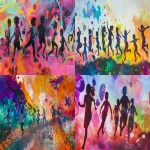Explore the Best AI Image Gallery

AI: The New Brushstroke - Reshaping the Graphic Design Landscape
The world of graphic design is undergoing a profound transformation, fueled by the rapid advancements in artificial intelligence (AI). No longer confined to science fiction, AI is becoming an integral part of the creative process, offering designers new tools and possibilities while raising important ethical considerations. This blog post explores the multifaceted impact of AI on graphic design, examining its potential uses, benefits, and the challenges that lie ahead.
Expanding Creative Horizons: Applications of AI in Graphic Design
AI is already making its mark on various aspects of graphic design:
- Logo Generation: AI algorithms can analyze trends, generate unique logo concepts based on specific requirements, and even iterate designs based on user feedback.
- Typography and Font Creation: AI can assist in designing new typefaces, experimenting with different styles, and optimizing font pairings for visual harmony.
- Image Editing and Manipulation: AI-powered tools can automate tedious tasks like removing backgrounds, adjusting colors, and enhancing image quality, freeing up designers for more creative endeavors.
- Content Creation: AI can generate textual content for marketing materials, website copy, or even captions for social media posts, saving designers time and effort.
- Personalized Designs: AI algorithms can analyze user data and preferences to create personalized designs that resonate with individual tastes.
The Advantages of Embracing AI in Graphic Design
The integration of AI offers numerous advantages for graphic designers:
- Increased Efficiency and Productivity: Automating repetitive tasks allows designers to focus on more conceptual and creative aspects of their work.
- Enhanced Creativity and Innovation: AI can provide designers with novel ideas, inspire unconventional approaches, and push the boundaries of design.
- Data-Driven Design Decisions: AI algorithms can analyze user data and trends to inform design choices, leading to more effective and impactful designs.
- Accessibility for All: AI-powered tools can empower individuals with limited design experience to create professional-quality visuals.
Navigating the Ethical Landscape
As with any powerful technology, the use of AI in graphic design raises ethical considerations:
- Bias and Fairness: AI algorithms are trained on data, which can contain biases that reflect societal inequalities. It is crucial to ensure that AI-generated designs are fair and inclusive.
- Copyright and Ownership: The question of copyright ownership for AI-generated artwork remains a complex and evolving issue.
- Transparency and Explainability: Designers should strive for transparency in their use of AI, clearly communicating how it is being used in the creative process.
- Job Displacement: While AI can augment human creativity, there are concerns about potential job displacement for graphic designers. It is essential to focus on retraining and upskilling programs to prepare for these changes.
The Future of Design: A Collaborative Landscape
The future of graphic design lies in a collaborative relationship between humans and AI.
- AI as a Creative Partner: AI will act as a powerful tool to assist designers, augment their skills, and unlock new possibilities.
- Human Creativity Remains Essential: The human element of empathy, intuition, and artistic vision will continue to be vital in shaping meaningful and impactful designs.
- Evolving Skillsets: Graphic designers will need to adapt and embrace new skillsets, including data literacy, AI proficiency, and a deep understanding of ethical considerations.
As AI continues to evolve, its influence on graphic design will only grow. By embracing this transformative technology responsibly and ethically, we can create a future where AI empowers designers to reach new heights of creativity and innovation.





](https://images.ai-img.art/thumbnails/150/44b76c49c47b4c47f13eac7883c63827d3f89aa77fe64ce0cbecb9d3ce434499.webp)













](https://images.ai-img.art/thumbnails/150/47d44e177f427ea6b32f96ea225db96c5158850a0cf01d1bad93e45dd4594430.webp)






](https://images.ai-img.art/thumbnails/150/c2241c1eabdcb7b9a98be19a7e8d850b6cffe0e0c91c1ccda8dd807e2a96b187.webp)




](https://images.ai-img.art/thumbnails/150/09ccae5e68e2b6da6b5da87ef69f7eb09e80c99ca39ba886c5c3773cbb3b89ba.webp)




](https://images.ai-img.art/thumbnails/150/c48401bc3fad7ff7f2dbd37b894d3f53cb42d5072dfacb8bfdcdeeef28a29b04.webp)












